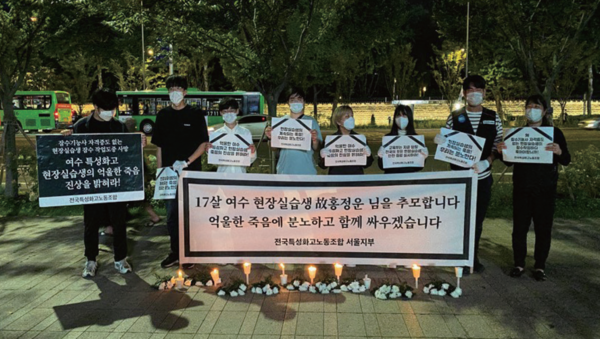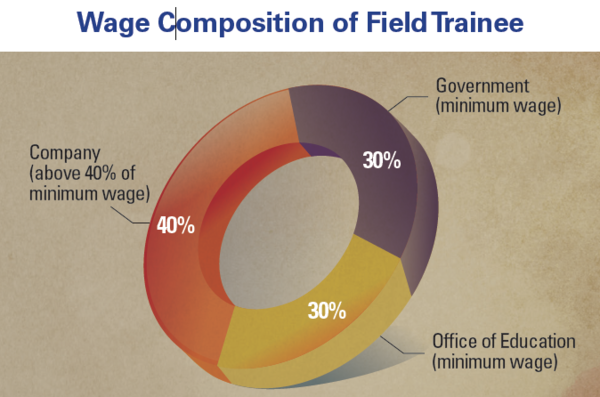The movie Next Sohee, released on Netflix in July, tells the tragic story of a former field trainee, Sohee. In the movie, the violence and unjust working conditions she experienced at a call center made her take her own life. The sorrow of the sacrificed Sohees conveyed by the film brought attention to the issues within vocational high school field training. In response, the Sungkyun Times (SKT) examined the history, current state, and potential solutions for a better future of field training undertaken by vocational high schools.
Nothing Has Changed
-Field Training for the Youth
A vocational high school operates specialized educational programs to cultivate talents and professionals in specific fields of industry. Field training is a part of the educational curriculum intended to provide students with various occupational experiences and help them adapt to industrial settings by allowing them to apply knowledge and skills learned in school to actual industrial environments. Field training can take three forms: in-school educational activities, experiential learning in industrial settings, and industry-dispatched practical training. Among them, the third type of training, which offers an attractive opportunity for early employment, has consistently been controversial. Since vocational high schools are categorized as vocational education and training institutions under the law, students must follow the same practical training obligations as adult workers in general vocational training institutions. The Vocational Education and Training Promotion Act thereby exists to clarify the legal relationships in in-field training. The law requires students to sign field training contracts based on standard agreements and protects their rights by imposing fines on the head of a company in case of contract violations. While the training is mainly operated under this act, a few provisions of the Labor Standards Act are further applied to ensure the students’ rights. The applied regulations are set to expand from October 19th.
-The Vicious Circle of Post Management

The field training system was officially introduced in 1963 through the Industrial Education Promotion Act when schools with insufficient training resources started sending students to industrial sites for practical training. However, since the focus was solely on fostering industrial workers, there was inadequate preparation to fully protect students in the workplace. The trend continued, eventually leading a trainee to death in an elevator accident in 2005. This incident revealed that students had not received basic safety education or protective equipment during the training. In response, measures were introduced requiring students to complete two-thirds of their second-semester courses in their third year. Also, the revision allowed students to participate in field training only after their post-graduation employment is guaranteed. These requirements, which significantly reduced field training, were abolished two years later by the Lee Myung-bak administration. In 2010, the government set a goal to raise employment rates, causing schools to overly focus on achieving high employment rate numbers. There was also an attempt in 2017 to eliminate dispatched field training to prevent potential safety problems. However, it faced opposition from students demanding training for early employment. Hence, a revised plan for dispatched field training was adopted in 2018, allowing students to be employed in leading companies that met specific criteria. However, this system was adjusted in 2019, allowing companies unselected as leading companies to accept trainees under the title of “participating companies.” This change led to an incident where a student named Hong Jeong-woon lost his life during an internship at a participating company. In the wake of numerous cases, improvements in selecting participating companies have been suggested.
Staring at the Root of the Problem
-The Reality of the Ambiguous Education System
In 2018, the field training system shifted from the previous practice where labor and field training contracts were signed simultaneously, to a learning-centered approach solely based on field training contracts. This shift classified field trainees as students rather than workers. However, despite its intention to protect the trainees as students, the problem of trainees not being clearly defined as either students or workers has continued.
1. Just a Trainee, Not a Worker?

First, the learning-centered training removes the trainees’ identity as workers. The field trainees sign a standard agreement, meaning the contract does not have specific enforceable rights. This means that when employers do not guarantee trainees’ rights, trainees can only file civil lawsuits. Starting in 2022, the Office of Education and the government have supported 30% of the minimum wage to reduce the burden on companies, with companies responsible for the remaining 40%. However, this 40% is only required to be the same or more than the 40% of the minimum wage, explaining that students may not even receive their minimum wage. Accordingly, the National Vocational High School Labor Union held a press conference on July 2nd, demanding the establishment of field training labor contracts and the assurance of the minimum wage. Kim Geun-han, a labor attorney, mentioned in an interview with the SKT, “It would be better if field training programs could provide a dual benefit for both labor and education, but it is doubtful whether these two can be pursued simultaneously.”
2. Learning-Centered, or Student-Centered?
Additionally, actual learning-centered field training has still not been established. While major suitability is a prerequisite for the training, this requirement is assessed only through documents. Therefore, if a company changes the job fields and tasks submitted in its operational plan, students may take field training unrelated to their major. Apart from these systemic flaws, since teachers’ promotions and school performance investigations are primarily tied to employment rates, teachers often prioritize maximizing the number of employment while neglecting major suitability. Furthermore, students who return to school early due to issues with their training companies are not guaranteed a regular education process. The laws only specify the supervision after returning to school, without mentioning the student’s right to receive regular education.
-A System Not for Students
Companies operating field training are divided into leading companies, which are recognized as having great working conditions, and participating companies. Leading companies first undergo a pre-site inspection, which examines the conditions and welfare of the company. The school’s labor attorneys conduct coaching for the company during this stage. Following this pre-inspection, leading companies apply for the program, and the school submits the program operational plan. Subsequently, the application must be approved by the Field Training Committee. Participating companies, however, only require approval from a site inspection and the field training operating committee.
1. Loopholes in Selecting Companies
The loopholes in selecting leading companies may expose the students to hazardous environments. To specify, the chart used in the pre-site inspection consists of qualitative evaluation criteria and may be subject to the inspector’s discretion. In fact, according to the statistics released by the Human Rights Commission in 2022, some training environments were evaluated as safe despite containing unverified chemicals on site. Moreover, the Field Training Committee limits the participation of parents to a few, and students do not even have the opportunity to participate in the process. The coaching by labor attorneys is distant from an objective inspection as it is based on the subjective judgment of company representatives. Fundamentally, there are concerns about how the level of coaching quality varies due to the difference in the number of labor attorneys between metropolitan and non-metropolitan areas.
2. Employment Rates, the Only Surveillance Target

The problems are not only limited to companies. The main problem of the schools is that they only focus on employment rates when they should provide high-quality work environments for their students. According to the Human Rights Commission, there were cases in which no action was taken despite issues such as overtime labor hours being verifiable through the field training management system, referred to as Hi-Five. The government is also responsible for this issue since it uses employment rates as evaluation criteria. Furthermore, although it is crucial for the Ministry of Education (MOE) to conduct regular surveys regarding the state of training experiences, it has only relied on the Hi-Five system until now. Also, the Unfair Treatment Reporting Center currently does not manage consultation records and results from the Hi-Five system. Moreover, central-level inspections are conducted only for about 30 schools nationwide. The results are also closed to the public, which limits access to objective information.
To Ensure Better Field Training
-One Pitch for Killing Two Birds

Since students still view the training system as an opportunity for education, improving the system would be much more appropriate than abolishing it. Therefore, a fundamental approach to a safe training environment is necessary. Germany’s vocational education and training system, combining theoretical learning in school and field training, could be a great reference. This dual system is under the MOE, minimizing the gap between education and labor programs. Korea could consider adopting such an approach to solve the current system’s ambiguity. Furthermore, Germany guarantees both education rights and minimum wage, protecting the student’s identity as a worker. In the current context of Korea, a priority should be the establishment of a government-level employment support agency targeting the youth. The system should aim to ensure high-quality jobs without being driven by meaningless quantitative indicators. This step could help address the fundamental problem that vocational high schools serve as a straightforward pathway to early employment. Moreover, to ensure the right to education for every student, the relevant regulations should specify the provision of education after the student returns from the center.
-Closing off the Vicious Circle
Systemic improvements are imperative, considering the flaws in the selection process of leading companies. First, participation by parents in the Field Training Committee, currently limited to only two Offices of Education, should be expanded, along with the student’s involvement. Also, enhancing the authority of labor attorneys, even after the student is hired, is essential. Establishing standardized procedures for the entire coaching process is also necessary. Regarding this, labor attorney Kim responded, “Even after the students get employed, assigning them a ‘homeroom labor attorney’ who may advance the legal structure against unfair treatment would be a solution.” To change the school’s perspective on field training, policies regarding vocational high schools should prohibit the use of employment rate indicators. Simultaneously, developing tools and statistics for evaluating students’ academic performance would be crucial. Furthermore, in vocational education policies, guaranteeing the participation of student labor unions and other stakeholders can further protect students’ rights. Finally, the MOE should regularly conduct comprehensive surveys beyond the Hi-Five system and monitor carefully and consistently to break the vicious cycle.
Until now, vocational high school field training has followed the history of “mending the barn after losing the calf.” It has repeatedly taken steps backward, trimming the leaves rather than addressing the root under the guise of improvement. As members of society, Kingos should watch and work toward a field training system that aligns with what students truly want as their experiential learning.
